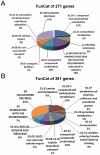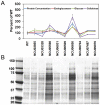Identification of the CRE-1 cellulolytic regulon in Neurospora crassa
- PMID: 21980519
- PMCID: PMC3183063
- DOI: 10.1371/journal.pone.0025654
Identification of the CRE-1 cellulolytic regulon in Neurospora crassa
Abstract
Background: In filamentous ascomycete fungi, the utilization of alternate carbon sources is influenced by the zinc finger transcription factor CreA/CRE-1, which encodes a carbon catabolite repressor protein homologous to Mig1 from Saccharomyces cerevisiae. In Neurospora crassa, deletion of cre-1 results in increased secretion of amylase and β-galactosidase.
Methodology/principal findings: Here we show that a strain carrying a deletion of cre-1 has increased cellulolytic activity and increased expression of cellulolytic genes during growth on crystalline cellulose (Avicel). Constitutive expression of cre-1 complements the phenotype of a N. crassa Δcre-1 strain grown on Avicel, and also results in stronger repression of cellulolytic protein secretion and enzyme activity. We determined the CRE-1 regulon by investigating the secretome and transcriptome of a Δcre-1 strain as compared to wild type when grown on Avicel versus minimal medium. Chromatin immunoprecipitation-PCR of putative target genes showed that CRE-1 binds to only some adjacent 5'-SYGGRG-3' motifs, consistent with previous findings in other fungi, and suggests that unidentified additional regulatory factors affect CRE-1 binding to promoter regions. Characterization of 30 mutants containing deletions in genes whose expression level increased in a Δcre-1 strain under cellulolytic conditions identified novel genes that affect cellulase activity and protein secretion.
Conclusions/significance: Our data provide comprehensive information on the CRE-1 regulon in N. crassa and contribute to deciphering the global role of carbon catabolite repression in filamentous ascomycete fungi during plant cell wall deconstruction.
Conflict of interest statement
Figures









Similar articles
-
Deciphering transcriptional regulatory mechanisms associated with hemicellulose degradation in Neurospora crassa.Eukaryot Cell. 2012 Apr;11(4):482-93. doi: 10.1128/EC.05327-11. Epub 2012 Feb 17. Eukaryot Cell. 2012. PMID: 22345350 Free PMC article.
-
VIB1, a link between glucose signaling and carbon catabolite repression, is essential for plant cell wall degradation by Neurospora crassa.PLoS Genet. 2014 Aug 21;10(8):e1004500. doi: 10.1371/journal.pgen.1004500. eCollection 2014 Aug. PLoS Genet. 2014. PMID: 25144221 Free PMC article.
-
Induction of lignocellulose-degrading enzymes in Neurospora crassa by cellodextrins.Proc Natl Acad Sci U S A. 2012 Apr 17;109(16):6012-7. doi: 10.1073/pnas.1118440109. Epub 2012 Apr 2. Proc Natl Acad Sci U S A. 2012. PMID: 22474347 Free PMC article.
-
[Mechanisms and regulation of enzymatic hydrolysis of cellulose in filamentous fungi: classical cases and new models].Rev Iberoam Micol. 2015 Jan-Mar;32(1):1-12. doi: 10.1016/j.riam.2013.10.009. Epub 2014 Mar 7. Rev Iberoam Micol. 2015. PMID: 24607657 Review. Spanish.
-
Conservation and diversity of the regulators of cellulolytic enzyme genes in Ascomycete fungi.Curr Genet. 2017 Dec;63(6):951-958. doi: 10.1007/s00294-017-0695-6. Epub 2017 Apr 27. Curr Genet. 2017. PMID: 28451846 Review.
Cited by
-
MtTRC-1, a Novel Transcription Factor, Regulates Cellulase Production via Directly Modulating the Genes Expression of the Mthac-1 and Mtcbh-1 in Myceliophthora thermophila.Appl Environ Microbiol. 2022 Oct 11;88(19):e0126322. doi: 10.1128/aem.01263-22. Epub 2022 Sep 27. Appl Environ Microbiol. 2022. PMID: 36165620 Free PMC article.
-
A transcriptomic analysis of Neurospora crassa using five major crop residues and the novel role of the sporulation regulator rca-1 in lignocellulase production.Biotechnol Biofuels. 2015 Feb 12;8:21. doi: 10.1186/s13068-015-0208-0. eCollection 2015. Biotechnol Biofuels. 2015. PMID: 25691917 Free PMC article.
-
Crosstalk of Cellulose and Mannan Perception Pathways Leads to Inhibition of Cellulase Production in Several Filamentous Fungi.mBio. 2019 Jul 2;10(4):e00277-19. doi: 10.1128/mBio.00277-19. mBio. 2019. PMID: 31266859 Free PMC article.
-
Carbon Catabolite Repression in Filamentous Fungi.Int J Mol Sci. 2017 Dec 24;19(1):48. doi: 10.3390/ijms19010048. Int J Mol Sci. 2017. PMID: 29295552 Free PMC article. Review.
-
Evidence of a critical role for cellodextrin transporte 2 (CDT-2) in both cellulose and hemicellulose degradation and utilization in Neurospora crassa.PLoS One. 2014 Feb 20;9(2):e89330. doi: 10.1371/journal.pone.0089330. eCollection 2014. PLoS One. 2014. PMID: 24586693 Free PMC article.
References
-
- Carroll A, Somerville C. Cellulosic biofuels. Annu Rev Plant Biol. 2009;60:165–182. - PubMed
-
- Somerville C, Bauer S, Brininstool G, Facette M, Hamann T, et al. Toward a systems approach to understanding plant cell walls. Science. 2004;306:2206–2211. - PubMed
-
- Ruijter GJ, Visser J. Carbon repression in Aspergilli. FEMS Microbiol Lett. 1997;151:103–114. - PubMed
-
- Aro N, Pakula T, Penttila M. Transcriptional regulation of plant cell wall degradation by filamentous fungi. FEMS Microbiol Rev. 2005;29:719–739. - PubMed
Publication types
MeSH terms
Substances
LinkOut - more resources
Full Text Sources
Other Literature Sources
Molecular Biology Databases

